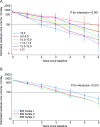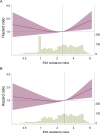Renal anemia and hyporesponsiveness to ESA for preservation of residual kidney function in patients undergoing peritoneal dialysis
- PMID: 39838061
- PMCID: PMC11751488
- DOI: 10.1038/s41598-025-87456-z
Renal anemia and hyporesponsiveness to ESA for preservation of residual kidney function in patients undergoing peritoneal dialysis
Abstract
Preservation of residual kidney function (RKF) is important in patients undergoing peritoneal dialysis (PD). We aimed to examine the association between anemia management and residual urine output using data from a nationwide survey of dialysis patients. After excluding patients with anuria at baseline from the Total cohort of 2,712, 659 of 1,640 patients developed anuria during a median follow-up of 2.5 (interquartile range: 1.5-4.2) years. Urine volume decreased more rapidly as hemoglobin decreased or as the erythropoiesis-stimulating agent (ESA) resistance index (ERI) increased. The hazard ratios with 95% confidence intervals for the development of anuria, defined as residual urine volume ≤ 100 mL/day, were 1.65 (1.20-2.27), 1.39 (1.08-1.77), and 1.32 (1.07-1.63) for hemoglobin levels of < 9.0, 9.0-9.9, and 10.0-10.9 g/dL compared with 11.0-11.9 g/dL, and 1.35 (1.10-1.66) and 1.41 (1.14-1.73) for the second and third tertiles of ERI compared with the first tertile. In conclusion, patients with a low hemoglobin level or a high ERI were more likely to experience a decline in residual urine output and to develop anuria. Further studies are needed to investigate the effects of interventions that could improve renal anemia and/or ESA hyporesponsiveness on RKF preservation.
Keywords: Anuria; Erythropoiesis-stimulating agent resistance index; Hyporesponsiveness to erythropoiesis-stimulating agent; Peritoneal dialysis; Residual kidney function.
© 2025. The Author(s).
Conflict of interest statement
Declarations. Competing interests: TI received a research grant from Kyowa Kirin Co., Ltd. and a consultation fee from GlaxoSmithKline. TH received a research grant from JSPS KAKENHI (Grant Number 19K03092 and 24K06239), and honoraria from Kyowa Kirin, Baxter, Terumo, and Torii Pharmaceutical. TKo received honoraria from Kowa, Torii, Sanwa Kagaku Kenkyusyo, and AstraZeneca. HN received speaker honoraria from Kyowa Kirin, Baxter, Terumo, Ono Pharmaceutical Co. Ltd., Daiichi-Sankyo, and Kissei Pharmaceutical Co. Ltd. MA received honoraria from Kyowa Kirin, Baxter, Terumo, Mitsubishi Tanabe, Torii, Bayer Yakuhin, and Astellas. HH is a scientific advisor for Astellas Pharma, Bayer Yakuhin, Kyowa Kirin, Mitsubishi Tanabe Pharma, and Torii Pharmaceutical and has obtained research funds from Chugai Pharmaceutical, Kyowa Kirin, Otsuka Pharmaceutical, and Torii Pharmaceutical and lecture fees from Astellas Pharma, Bayer Yakuhin, Chugai Pharmaceutical, Kissei Pharmaceutical, Kyowa Kirin, Mitsubishi Tanabe Pharma, and Torii Pharmaceutical. KT received honoraria from Kyowa Kirin, Mitsubishi-Tanabe, Astellas, Torii, Bayer, Baxter, Kissei, and Chugai and endorsements from Kyowa Kirin, Baxter, Terumo, Torii, Chugai, and Bayer. YI received research grants and speaker honoraria from Chugai Pharmaceutical, Kyowa Kirin, Astellas Pharma, Mitsubishi Tanabe Pharma, Bayer, and Torii Pharmaceuticals. TKu received research grants from Ono Pharmaceutical Co., Ltd., Kissei Pharmaceutical Co., Ltd., speaker bureaus from Kyowa Kirin, Fuso Pharmaceutical Industries, Ltd., Mitsubishi Tanabe Pharma Corporation, Astellas Pharma Inc., AstraZeneca Plc., and Bayer Yakuhin Ltd. All the remaining authors have nothing to disclose.
Figures




Similar articles
-
Hyporesponsiveness to Erythropoiesis-Stimulating Agents in Dialysis-Dependent Patients with Anaemia of Chronic Kidney Disease: A Retrospective Observational Study.Adv Ther. 2025 Jan;42(1):471-489. doi: 10.1007/s12325-024-03015-4. Epub 2024 Nov 25. Adv Ther. 2025. PMID: 39581908 Free PMC article.
-
Changes in erythropoiesis-stimulating agent responsiveness after transfer to combined therapy with peritoneal dialysis and hemodialysis for patients on peritoneal dialysis: A prospective multicenter study in Japan.Ther Apher Dial. 2023 Aug;27(4):735-741. doi: 10.1111/1744-9987.13981. Epub 2023 Mar 22. Ther Apher Dial. 2023. PMID: 36897071
-
Erythropoietin Resistance Index and the Affecting Factors in Children with Peritoneal Dialysis.Blood Purif. 2021;50(6):942-951. doi: 10.1159/000514060. Epub 2021 Mar 30. Blood Purif. 2021. PMID: 33784664
-
Association of Erythropoietin-Stimulating Agent Responsiveness with Mortality in Hemodialysis and Peritoneal Dialysis Patients.PLoS One. 2015 Nov 20;10(11):e0143348. doi: 10.1371/journal.pone.0143348. eCollection 2015. PLoS One. 2015. PMID: 26588085 Free PMC article.
-
Erythropoietin Hyporesponsiveness in Dialysis Patients: Possible Role of Statins.Am J Nephrol. 2017;46(1):11-17. doi: 10.1159/000477217. Epub 2017 Jun 1. Am J Nephrol. 2017. PMID: 28564644 Free PMC article.
References
-
- Perl, J. & Bargman, J. M. The importance of residual kidney function for patients on dialysis: a critical review. Am. J. Kidney Dis.53, 1068–1081 (2009). - PubMed
-
- Maiorca, R. et al. Predictive value of dialysis adequacy and nutritional indices for mortality and morbidity in CAPD and HD patients. A longitudinal study. Nephrol. Dial Transpl.10, 2295–2305 (1995). - PubMed
-
- Szeto, C. C. et al. Importance of dialysis adequacy in mortality and morbidity of Chinese CAPD patients. Kidney Int.58, 400–407 (2000). - PubMed
-
- Boudville, N. & de Moraes, T. P. Guidelines on targets for solute and fluid removal in adults being treated with chronic peritoneal dialysis: 2019 update of the literature and revision of recommendations. Perit. Dial Int.40, 254–260 (2005). (2020). - PubMed
-
- Marrón, B., Remón, C., Pérez-Fontán, M., Quirós, P. & Ortíz, A. Benefits of preserving residual renal function in peritoneal dialysis. Kidney Int.73, S42–S51 (2008). - PubMed
Publication types
MeSH terms
Substances
Grants and funding
LinkOut - more resources
Full Text Sources
Medical

